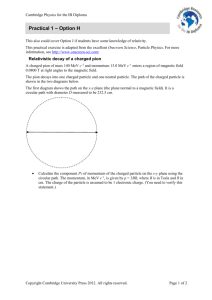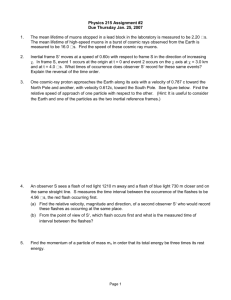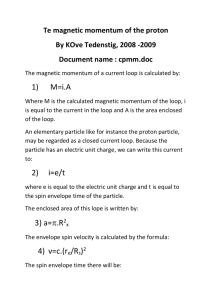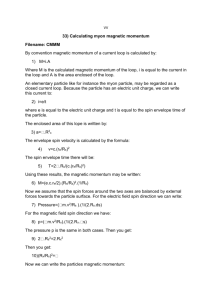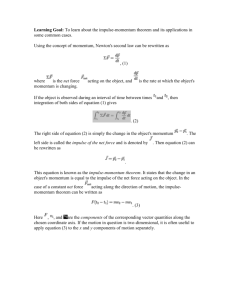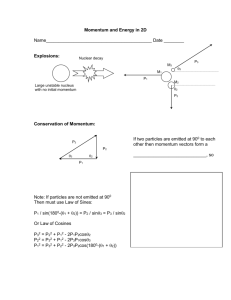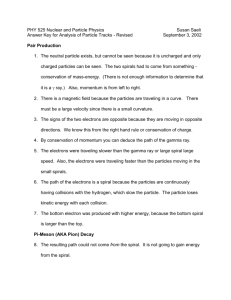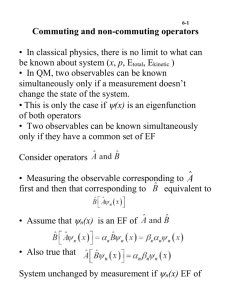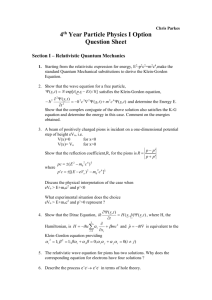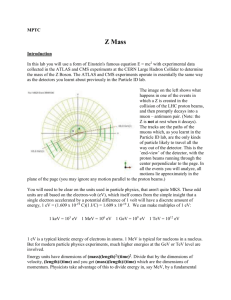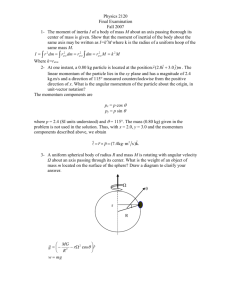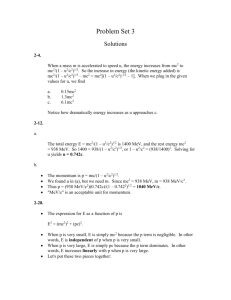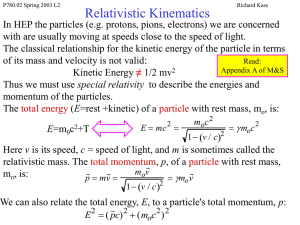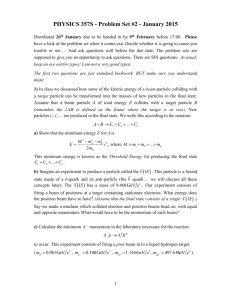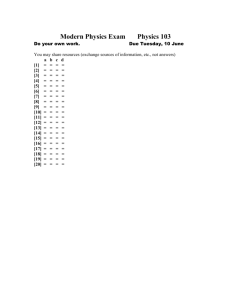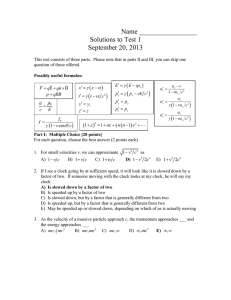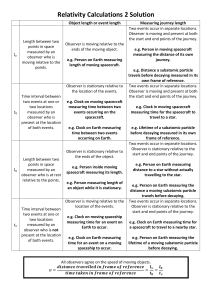doc
advertisement
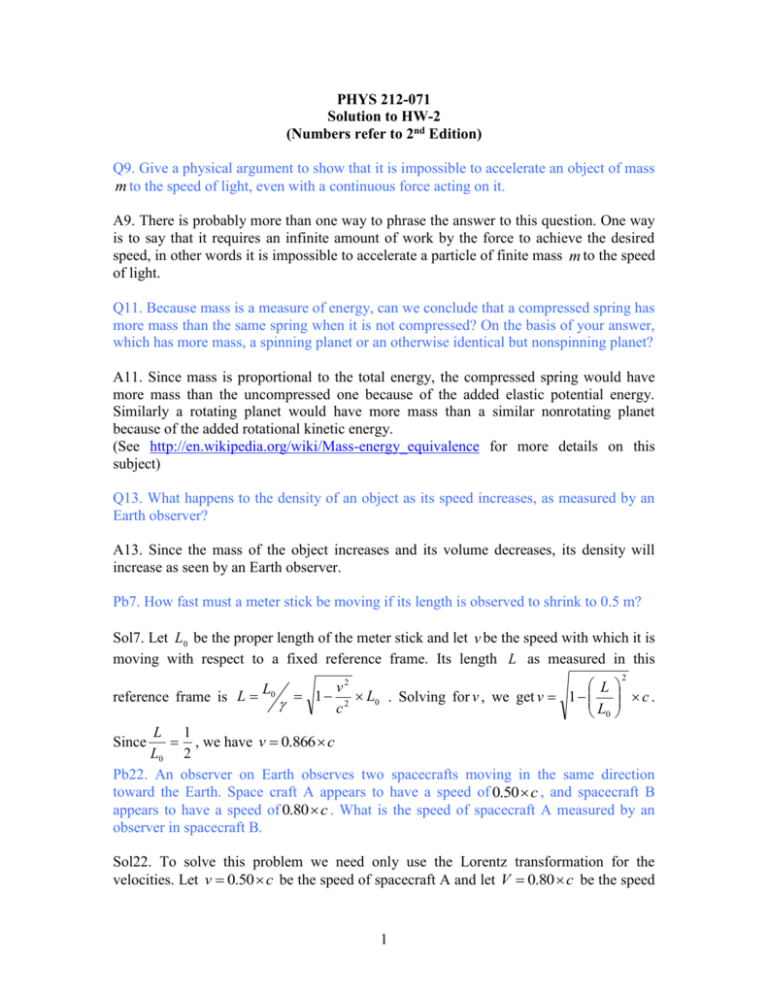
PHYS 212-071 Solution to HW-2 (Numbers refer to 2nd Edition) Q9. Give a physical argument to show that it is impossible to accelerate an object of mass m to the speed of light, even with a continuous force acting on it. A9. There is probably more than one way to phrase the answer to this question. One way is to say that it requires an infinite amount of work by the force to achieve the desired speed, in other words it is impossible to accelerate a particle of finite mass m to the speed of light. Q11. Because mass is a measure of energy, can we conclude that a compressed spring has more mass than the same spring when it is not compressed? On the basis of your answer, which has more mass, a spinning planet or an otherwise identical but nonspinning planet? A11. Since mass is proportional to the total energy, the compressed spring would have more mass than the uncompressed one because of the added elastic potential energy. Similarly a rotating planet would have more mass than a similar nonrotating planet because of the added rotational kinetic energy. (See http://en.wikipedia.org/wiki/Mass-energy_equivalence for more details on this subject) Q13. What happens to the density of an object as its speed increases, as measured by an Earth observer? A13. Since the mass of the object increases and its volume decreases, its density will increase as seen by an Earth observer. Pb7. How fast must a meter stick be moving if its length is observed to shrink to 0.5 m? Sol7. Let L0 be the proper length of the meter stick and let v be the speed with which it is moving with respect to a fixed reference frame. Its length L as measured in this 2 reference frame is L L0 L v2 1 2 L0 . Solving for v , we get v 1 c . c L0 L 1 , we have v 0.866 c L0 2 Pb22. An observer on Earth observes two spacecrafts moving in the same direction toward the Earth. Space craft A appears to have a speed of 0.50 c , and spacecraft B appears to have a speed of 0.80 c . What is the speed of spacecraft A measured by an observer in spacecraft B. Since Sol22. To solve this problem we need only use the Lorentz transformation for the velocities. Let v 0.50 c be the speed of spacecraft A and let V 0.80 c be the speed 1 of a reference frame moving with spacecraft B. The speed v of spacecraft A measured by the moving reference frame is v V v 0.5 c v V 1 2 c Pb31. Show that the momentum of a particle having charge e moving in a circle of radius R in a magnetic field B is given by p 300 BR , where p is in MeV/c, B is in teslas, and R is in meters. Sol31. Let p mv be the momentum of the particle. Since the particle is moving in a circle under the influence of a magnetic field B , its speed is constant and the only acceleration is the centripetal acceleration. We have dp d dv dv v2 v v F mv m F m m mv p dt dt dt dt R R R On the other hand, the Lorentz force acting the particle is F ev B F evB We used the fact that the particle is moving at right angle with respect to the magnetic field. Equating the two expressions for the force F , we get v ceBR p evB p eBR , R c c is the speed of light. Notice that the units of ceBR are m / s C T m C m / s T m N m J , where use has been made of the Lorentz magnetic force formula. On the other hand, since 1 eV = 1.6 x 10 -19 J, and eV since e = 1.6 x 10-19 C, the formula for p becomes p cBR . Since c 3 10 8 m/s c MeV and since 1 MeV = 106 eV, we get p 300 BR c Pb41. A noted in section 1.8, the quantity E 2 p 2 c 2 is an invariant in relativistic theory. This means that the quantity E 2 p 2 c 2 has the same value in all inertial frames even though E and p have different values in f=different frames. Show this explicitly by considering the following case. A particle of mass m is moving in the x direction with speed v and has momentum p and energy E in the frame S. (a) If S’ is moving with speed V in the standard way, find the momentum p’ and energy E’ observed in S’. Is E = E’ and p = p’? (b) Show that E 2 p 2 c 2 is explicitly equal to E 2 p 2 c 2 . Sol41. Let E and p be the energy and momentum of the particle of proper mass m in the frame S. We have E mc 2 and p mv . One can easily show that E 2 p 2 c 2 m 2 c 4 . Let E’ and p’ be the energy and momentum of the same particle as seen in a frame S’. We have: 2 (a) v E p mc 2 v 2 1 2 c mv v 2 1 2 c v V vV 1 2 c mc 2 1 v V 1 2 vV c 1 2 c v V m vV 1 2 c 1 v V 1 2 vV c 1 2 c E p (b) Upon squaring and subtracting we get v V 2 4 2 2 m c m c 1 vV 2 c 2 2 2 E p c 2 1 v V 1 2 vV c 1 2 c QED 3 2 m2c 4
